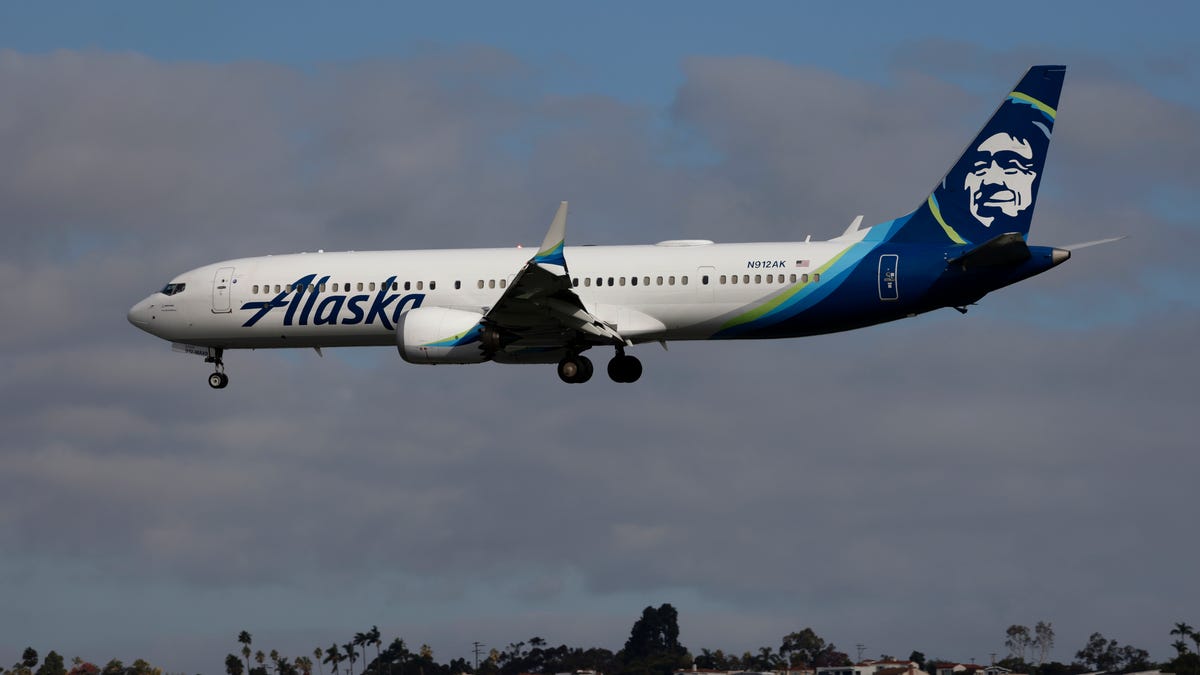Alaska
Alaska Airlines to offer direct flights to Las Vegas from SLO Regional Airport

Alaska Airlines announced Thursday that they will provide nonstop flights from San Luis Obispo to Las Vegas and vice versa starting at the end of the year.
The airline currently has three different nonstop flights daily from San Luis Obispo to Seattle, San Diego and Portland.
“It’s really exciting for us now to be able to offer to the entire region a daily nonstop flight to Las Vegas,” Courtney Pene, deputy director of planning and outreach for the San Luis Obispo Regional Airport said.
There will only be one round-trip flight per day for travelers. The flight to Las Vegas will depart at 9 a.m. and land at 10:14 a.m.
The returning flight will leave in the evening from Las Vegas at 7:55 p.m. and land in San Luis Obispo around 9 p.m.
The first of these nonstop flights will be on Thursday, Dec. 14 — leaving from Vegas and landing in San Luis Obispo. The first departure from San Luis Obispo to Las Vegas will be Friday, December 15.
Some residents are happy about the change.
Maya Siguenza, a Pismo resident, says she has family in Vegas that she has not been able to visit in quite some time.
“I didn’t get to see them because of flights and I don’t want to drive over there,” Siguenza said.
“I have reason to go to Vegas for business every once in a while and that will make it much easier,” Pismo Beach resident, Jason Natnason, said.
According to officials from the San Luis Obispo airport, there was a growing demand for travelers between those two destinations.
The airport predicts this year will be a record-busy year for them.
“In 2022 we hit our highest number which is 554,000 passengers, so we do expect to exceed that number,” Pene said.
With a predicted increase in travelers, the San Luis Obispo airport advises travelers to arrive two hours before their flight — especially if they are checking in baggage.

Alaska
Ted Stevens Anchorage International Airport busy with holiday travelers

ANCHORAGE, Alaska (KTUU) -Many of the people arriving to and departing from Ted Stevens Anchorage International Airport Sunday agreed that Anchorage’s main airport isn’t as tough to navigate as most right now.
On Dec. 22, three days out from both Hanukkah and Christmas, travelers at the airport were lined up, checking in, waiting for baggage, or going through security; all of those, demanding a wait. However, several travelers told Alaska’s News Source about their experiences and what they were expecting during their flights.
Matt Howard departed from Raleigh-Durham International Airport in North Carolina around 5 a.m. “It was the busiest I’ve ever seen it,” Howard said. He estimated he touched down in Anchorage around 6 p.m., adding Ted Stevens was much “less frantic” than the other airports he was at, but thought the evening time frame might have been a contributing factor.
Flying in from Hartsfield-Jackson International Airport in Atlanta, Georgia, Kimberly Lamar said she visits her mother in Alaska at least once a year.
“It was pretty overwhelming, trying to get through from Atlanta,” she said. “Then I got to Seattle; it was hard to get through to the gates of Seattle. And finally, this is the easiest airport I’ve actually been in all day.”
Born and raised in Alaska, Gideon Mahoney was traveling to Colorado where he recently relocated. “I’m actually really surprised, right now it’s easy and we were a little late, so…” Mahoney said, glancing at the line for security.
Growing up in Alaska, Mahoney said flying into Denver International Airport can be overwhelming at times.
“We’re working on figuring out how to deal with that,” he said. “We’re getting it.”
As for travelers who haven’t left just yet, Lamar’s advice was aligned with a prepared statement from Alaska Airlines: both said arriving early is the key for holiday travels.
“If you’re flying, make sure you leave early because those lines are crucial,” Lamar said.
See a spelling or grammar error? Report it to web@ktuu.com
Copyright 2024 KTUU. All rights reserved.
Alaska
Hydroponics provide year-round growing for Alaska farmers

On a recent December afternoon, Soldotna farmer Taylor Lewis preps for a day of harvesting crops. She walks to a tray filled with ripe lettuce and snips a head of it by the stem.
It’s just one of about 900 plants that Taylor and her mother-in-law Jayme Lewis will harvest and process this week – despite freezing temperatures and slushy snow outside. That’s because the duo works for Edgy Veggie, an indoor farm that grows produce year round.
“In the summer, a lot of our business drops off because folks are gardening at home. But in the winter, they’re not, because it costs money to heat your greenhouse,” Jayme said. “It costs a lot of money to heat your greenhouse.”
The company is a hydroponic farm, meaning they grow plants without soil. Hydroponic systems recycle and reuse nutrient-filled water, which minimizes waste. Specially made lighting and climate controlled conditions make it possible for Edgy Veggie to grow indoors during the winter months.
Around Thanksgiving, the company harvested 150 pounds of lettuce, enough to make about 800 salads. That took two days and was one of their biggest hauls of the year. Although not a typical harvest for the company, Jayme says she does see an uptick in business during the winter when Alaska’s produce is almost exclusively shipped up from the Lower 48.
“If you go to the grocery store and pick up a head of lettuce right now, by the time you get it home it will be wilted,” Jayme said. “That’s sad. Literally, that’s sad.”
Jayme says some local restaurants have sourced their vegetables from Edgy Veggie because they last longer and are fresher than grocery store produce.
Nestled between two train cars-turned-restaurants on the other side of town, Henry Krull walks inside his shipping container farm. He points to a wall that’s growing hundreds of bunches of butter lettuce.
Krull is the owner of fresh365, another Kenai Peninsula based hydroponic farm. Just like Edgy Veggie, the farm operates entirely indoors.
“The advantage of growing indoors, in a container like we have, is that we can control the environment,” Krull said. “We can grow no matter what’s going on outside. It can be 30 below outside, but it’s always 70 degrees or so inside.”
fresh365 also sees an uptick in direct-to-consumer sales in the winter. Otherwise, most of their sales go to other businesses, like local restaurants.

And while indoor farming means fresh, local produce year-round for Alaskans, it faces a number of challenges. Krull says growing in a hydroponic setting is much more expensive than traditional farming methods. So, to offset his farm’s energy costs, he installed solar panels, which were partially funded by the U.S. Department of Agriculture’s Rural Energy for America Program, or REAP.
But, Krull says the property doesn’t get much sunlight in the winter.
“The sun is a very valuable commodity, it’s valuable for not only producing electricity, but it helps to lower the energy costs,” he said. “And the energy costs of the farm containers we have is actually very, very high, because we can’t take advantage of the sun.”
Edgy Veggie, on the other hand, doesn’t even have solar panels. Jayme says their energy costs are high year round.
“Electricity, especially, is outrageous,” she said. “I wish that the state had some sort of option with the electric companies to help support farming. We’re providing a service to the community, honestly. We’re trying to, but it might run us out of business.”
Other challenges to hydroponics include faulty pumps and timers, ventilation issues and water leaks. Like traditional farming, hydroponic farmers say it’s backbreaking work.

But, for farmers like Taylor Lewis, offering fresh and local produce year round is a labor of love.
“Being able to supply our community with anything fresh is great,” Taylor said. “What we have as options in the grocery store – it’s not cutting it.”
“These belong in every community,” Krull said. “We’ve been able to prove that as a business model, it works. You can make a profit doing it, you can provide a good service to your community, and I think we can really do good for our community by providing something that is not readily available on a year-round basis.”
According to the U.S Department of Agriculture, only 5% of food Alaskans consume is grown locally. The state also has very short growing seasons.
Alaska
Nature: Northern Lights above Alaska

Watch CBS News
Be the first to know
Get browser notifications for breaking news, live events, and exclusive reporting.
-

 Politics1 week ago
Politics1 week agoCanadian premier threatens to cut off energy imports to US if Trump imposes tariff on country
-
/cdn.vox-cdn.com/uploads/chorus_asset/file/25789444/1258459915.jpg)
/cdn.vox-cdn.com/uploads/chorus_asset/file/25789444/1258459915.jpg) Technology1 week ago
Technology1 week agoOpenAI cofounder Ilya Sutskever says the way AI is built is about to change
-

 Politics1 week ago
Politics1 week agoU.S. Supreme Court will decide if oil industry may sue to block California's zero-emissions goal
-
/cdn.vox-cdn.com/uploads/chorus_asset/file/25546252/STK169_Mark_Zuckerburg_CVIRGINIA_D.jpg)
/cdn.vox-cdn.com/uploads/chorus_asset/file/25546252/STK169_Mark_Zuckerburg_CVIRGINIA_D.jpg) Technology1 week ago
Technology1 week agoMeta asks the US government to block OpenAI’s switch to a for-profit
-

 Business1 week ago
Business1 week agoFreddie Freeman's World Series walk-off grand slam baseball sells at auction for $1.56 million
-
/cdn.vox-cdn.com/uploads/chorus_asset/file/23951353/STK043_VRG_Illo_N_Barclay_3_Meta.jpg)
/cdn.vox-cdn.com/uploads/chorus_asset/file/23951353/STK043_VRG_Illo_N_Barclay_3_Meta.jpg) Technology1 week ago
Technology1 week agoMeta’s Instagram boss: who posted something matters more in the AI age
-
News1 week ago
East’s wintry mix could make travel dicey. And yes, that was a tornado in Calif.
-
/cdn.vox-cdn.com/uploads/chorus_asset/file/24924653/236780_Google_AntiTrust_Trial_Custom_Art_CVirginia__0003_1.png)
/cdn.vox-cdn.com/uploads/chorus_asset/file/24924653/236780_Google_AntiTrust_Trial_Custom_Art_CVirginia__0003_1.png) Technology2 days ago
Technology2 days agoGoogle’s counteroffer to the government trying to break it up is unbundling Android apps


















